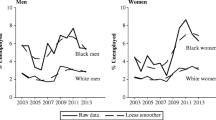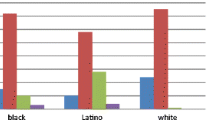Abstract
This article examines the interracial/ethnic differences in the United States in labor force positions among Puerto Ricans, blacks, Mexicans, Cubans, Chinese, and Japanese. The analysis is based on the Labor Utilization Framework developed by Hauser, Sullivan, Clogg, and others and the 1980 US Census data. Our results show that these minority groups differ in the ways in which they are utilized in the labor Iorce and that differential economic consequences are associated with interracial/ethnic differences in labor force utilization. In general, over 40 percent of the members of each of the minority groups are underemployed in the labor market in one way or another, though the ways in which they are underemployed vary. In particular, blacks and Puerto Ricans are hardest hit by labor force nonparticipation and by high rates of sub-unemployment and unemployment. Mexicans do not seem to be particularly hard hit by joblessness, but they fall disproportionately in categories of partial or low-wage employment. Chinese are most disadvantaged in adequate employment, but this disadvantage seems to be offset by high rates of low-wage employment and occupational mismatch. Cubans and Japanese have a relatively higher rate of adequate employment than other groups, and, at the same time, they manage to bypass the disadvantages of joblessness through occupational mismatch. These patterns of interracial/ethnic disparities persist in the labor market even after controlling for education and age. Another significant finding is that some forms of underemployment offer fewer disadvantages than others. Occupational mismatch, for example, may be an effective way to bring about substantial positive economic consequences.
Similar content being viewed by others
References
Alba, R.D. (1976). Social assimilation among American Catholic national origin groups,American Sociological Review 41: 1030–46.
Bean, F.D. & M. Tienda (1987).The Hispanic population of the United States. New York: Russell Sage Foundation.
Bean, F., L.L. Lowell & L.J. Taylor (1988). Undocumented Mexican immigrants and the earnings of other workers in the United States,Demography 25(1): 35–52.
Borjas, G.J. (1984). The Impact of immigrants on earnings of the native-born, in: V.M. Briggs, Jr. & M. Tienda (eds.),Immigration: Issues and policies. Salt Lake City, UT: Olympus.
Borjas, G.J. (1990).Friends and strangers: The impact of immigrants on the US economy. New York: Basic Books.
Chiswick, B.R. (1979). The economic progress of immigrants: Some apparently universal patterns,Contemporary Economic Problems. American Enterprise Institute.
Clogg, C.C. (1979).Measuring underemployment: Demographic indicators for the United States. New York: Academic Press.
Clogg, C.C., S.R. Eliason & R. Wahl (1990). Labor market experiences and labor force outcomes: A comprehensive framework for analyzing labor force dynamics,American Journal of Sociology 95(6): 1536–76.
Daniels, R. (1988).Asian Americans: Chinese and Japanese in the United States since 1850. Seattle, WA: University of Washington Press.
Gordon, M.M. (1964).Assimilation in American life. New York: Oxford University Press.
Greeley, A.M. (1976). The ethnic miracle,Public Interest 45: 20–36.
Hauser, P.M. (1977). The measurement of labor utilization: More empirical results,Malayan Economic Review 22: 10–25.
Hauser, P.M. (1974). The measure of labor utilization,Malayan Economic Review 19: 1–17.
Hirschman, C. & M.G. Wong (1984). Socioeconomic gains of Asian Americans, blacks and Hispanics: 1960–1976,American Journal of Sociology 90: 584–607.
Hirschman, C. & M.G. Wong (1986). The extraordinary educational attainment of Asian Americans: A Search for Historical evidence and explanations,Social Forces 65(1): 1–27.
Hurh, W.M. & K.C. Kim (1984).Korean immigrants in America: A structural analysis of ethnic confinement and adhesive adaptation. N.J.: Associated University Presses.
Jaynes, G.D. & R.M. Williams, Jr. (1991). A common destiny: black and American society, pp. 477–97, in: N.R. Norman (ed.),Majority and minority: The dynamics of race and ethnicity in American life (5th ed.). Boston: Allyn and Bacon.
Kasarda, D.J. (1983). Entry level jobs, mobility, and minority and unemployment,Urban Affairs Quarterly 19(1) 21–40.
Kirschenman, J. & K.M. Neckerman (1991). ‘We'd love to hire them, but ...’: The meaning of race for employers, pp. 203–243, in: C. Jencks & P.E. Peterson (eds.),The Urban Underclass. Washington DC: The Brookings Institute.
Landry, B. (1987).The New Black Middle Class. Berkeley: University of California Press.
Lichter, D.T. (1988). Racial difference in underemployment in American cities,American Journal of Sociology 93: 771–92.
Light, I. (1972).Ethnic enterprise in America: Business welfare among Chinese, Japanese and blacks. Berkeley: University of California Press.
Massey, D.S. (1979). Effects of socio-economic factors on the residential segregation of blacks and Spanish Americans in the U.S. urbanized areas,American Sociological Review 44: 1015–22.
Model, S. (1991). Caribbean immigrants: A black success story?International Migration Review 25: 248–76.
Portes, A. & R.L. Bach (1985).The Latin journey: Cuban and Mexican immigrants in the United States. Berkeley: University of California Press.
Portes, A. & C.G. Truelove (1987). Making sense of diversity: Recent research on Hispanic minorities in the United States, pp. 402–19, in: N.R. Yetman (ed.),Majority and Minority: The dynamics of race and ethnicity in American life. Boston: Allyn and Bacon.
Portes, A. & M. Zhou (1992). Gaining the upper hand: Economic mobility among immigrant and domestic minorities,Ethnic and Racial Studies 15(4) 491–522.
Reischauer, R.D. (1989). Immigration and the underclass.Annals of the American Academy of Political and Social Sciences 501: 120–31.
Sassen, S. (1988).The mobility of labor and capital. New York: Cambridge University Press.
Sullivan, T.A. (1978).Marginal workers, marginal jobs: Underutilization in the U.S. work force. Austin: University of Texas Press.
Takaki, R. (1989).Strangers from a different shore: A history of Asian Americans. Penguin Books.
Tienda, M. (1989). Puerto Ricans and the underclass,Annals of the American Academy of Political ancl Social Sciences 501: 105–19.
Tienda, M. & L. Jensen (1988). Poverty and minorities: A quarter century Profile of color and socioeconomic disadvantages, pp. 25–33, in: G.D. Sandefur & M. Tienda (eds.),Divided opportunities: Minorities, poverty, and social policy. New York: Plenum Press.
Tienda, M. and D.T. Lii (1987). Minority concentration and earnings inequality: blacks, Hispanics and Asians compared,American Journal of Sociology 2 (July): 141–25.
US Bureau of the Census (1983).Census of population and housing, 1980: Public-use microdata samples (A) [MRDF]. Washington DC: US Bureau of the Census.
US Bureau of the Census (1984).Census of population and housing, 1980: General social and economic characteristics, US summary. Washington DC: US Bureau of the Census.
Waldinger, R. (1989). Structural opportunities or ethnic advantage: Immigrant business development in New York,International Migrational Review 23: 48–72.
Warner W.L. & L. Srole (1945).The social systems of American ethnic groups. New Haven: Yale University Press.
Wilson, W.J. (1978).The declining significance of race: Blacks and changing American institutions. Chicago: University of Chicago Press.
Wilson, W.J. (1987).The truly disadvantaged. Chicago: University of Chicago Press.
Zhou, M. (1992).Chinatown: The socioeconomic potential of an urban enclave. Philadelphia: Temple University Press.
Zhou, M. & Y. Kamo (1992). An analysis of earnings patterns for Chinese, Japanese, and Non-Hispanic white males in the United States. Paper presented at the 1992 Annual Meeting of the Southwestern Social Science Association, Austin, TX (March 18–21).
Author information
Authors and Affiliations
Corresponding author
Rights and permissions
About this article
Cite this article
Zhou, M. Underemployment and economic disparities among minority groups. Popul Res Policy Rev 12, 139–157 (1993). https://doi.org/10.1007/BF01074562
Issue Date:
DOI: https://doi.org/10.1007/BF01074562




